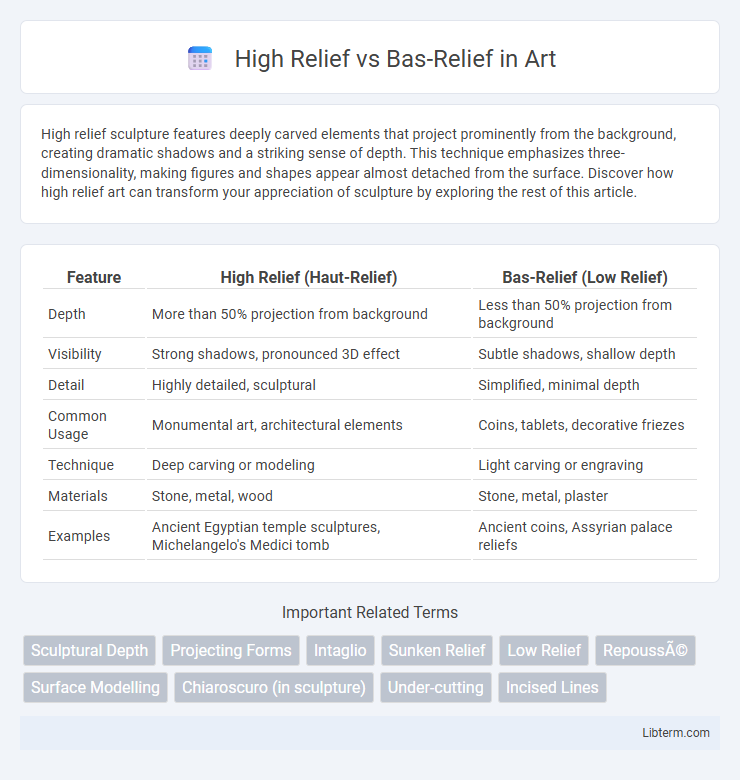High relief sculpture features deeply carved elements that project prominently from the background, creating dramatic shadows and a striking sense of depth. This technique emphasizes three-dimensionality, making figures and shapes appear almost detached from the surface. Discover how high relief art can transform your appreciation of sculpture by exploring the rest of this article.
Table of Comparison
| Feature | High Relief (Haut-Relief) | Bas-Relief (Low Relief) |
|---|---|---|
| Depth | More than 50% projection from background | Less than 50% projection from background |
| Visibility | Strong shadows, pronounced 3D effect | Subtle shadows, shallow depth |
| Detail | Highly detailed, sculptural | Simplified, minimal depth |
| Common Usage | Monumental art, architectural elements | Coins, tablets, decorative friezes |
| Technique | Deep carving or modeling | Light carving or engraving |
| Materials | Stone, metal, wood | Stone, metal, plaster |
| Examples | Ancient Egyptian temple sculptures, Michelangelo's Medici tomb | Ancient coins, Assyrian palace reliefs |
Introduction to Relief Sculpture
Relief sculpture is a technique where sculpted elements remain attached to a solid background of the same material, creating a raised design. High relief (alto-relievo) features figures that project significantly from the background, often with deep undercuts and more dimensionality, making the forms appear almost fully three-dimensional. Bas-relief (low relief) presents a shallower projection, with subtle depth that emphasizes surface detail while maintaining closer integration with the background plane.
Defining High Relief: Characteristics and Techniques
High relief, or alto-relievo, is a sculptural technique where forms project prominently from the background, often deeper than half their depth, creating dramatic shadows and a strong three-dimensional effect. This technique involves carving deeply into material like stone or wood, using undercutting to enhance depth and dynamic composition, making figures appear almost fully in the round. High relief is commonly used for monumental works and architectural decorations that demand striking visual impact and detailed craftsmanship.
Understanding Bas-Relief: Features and Methods
Bas-relief, characterized by shallow depth with slight projections from the background, creates subtle three-dimensional effects ideal for architectural friezes and coins. The technique involves carving or casting surfaces where figures remain mostly attached to the background, emphasizing contours and textures over full volumetric form. Understanding bas-relief methods includes mastering low carving depth, precise chiseling, and attention to light and shadow interplay to achieve detailed yet restrained visual depth.
Historical Origins and Evolution of Relief Sculptures
High relief and bas-relief sculptures trace back to ancient civilizations, with high relief featuring prominently in Assyrian and Egyptian art to create dramatic, lifelike figures that project deeply from the background, enhancing visual impact. Bas-relief, characterized by its shallow depth, was widely used in Greek and Roman cultures for narrative friezes and architectural decorations, allowing detailed storytelling on flat surfaces. Over centuries, these relief techniques evolved across cultures, influencing medieval, Renaissance, and modern art by adapting depth and perspective to fit artistic and cultural narratives.
Key Differences: High Relief vs Bas-Relief
High relief (alto-relievo) features deeply carved sculptures that project significantly from the background, often by more than half their depth, creating pronounced shadows and a strong three-dimensional effect. Bas-relief (low relief) involves shallow carving with figures barely raised from the surface, offering subtle depth ideal for intricate details and background scenes. The key differences lie in the depth of projection and visual impact, with high relief emphasizing dramatic, sculptural prominence and bas-relief prioritizing delicate, surface-level imagery.
Artistic Purposes and Applications
High relief sculpture features figures that project significantly from the background, creating dramatic depth and dynamic shadows ideal for monumental art and architectural decoration. Bas-relief offers a shallow depth, often less than half an inch, making it suitable for coin designs, medals, and narrative panels where subtle detail enhances storytelling. Artists choose high relief to emphasize realism and three-dimensionality, while bas-relief supports intricate scenes with refined textures in limited space.
Materials Used in Relief Artworks
High relief sculptures often use durable materials such as marble, bronze, and wood to withstand their pronounced three-dimensional depth, while bas-relief artworks typically employ softer materials like plaster, clay, and terracotta to accommodate their shallow carvings. Bronze casting is favored in high relief for its strength and detail retention, whereas bas-relief frequently involves stone or ceramic surfaces for fine surface intricacy. The choice of materials directly influences durability, texture, and detail clarity in both high relief and bas-relief artworks.
Iconic Examples in Art History
High relief sculpture, characterized by figures projecting significantly from the background, is exemplified by the Parthenon's metopes with their dramatic depth and lifelike forms. Bas-relief, where the carving is shallow and figures barely stand out from the surface, is famously seen in the Assyrian palace reliefs, which convey detailed narratives with subtle depth. Both techniques have defined artistic expression in different cultures, with high relief emphasizing dynamic movement and depth while bas-relief excels in storytelling through intricate surface detail.
Challenges in Creating Relief Sculptures
High relief sculptures present challenges in maintaining structural stability due to their deep carving and pronounced three-dimensionality, often requiring careful support to prevent breakage. Bas-relief demands precise control over shallow depths to create nuanced textures and depth perception without compromising flatness, which can limit detail expression. Artists must balance material constraints and visual impact when selecting between high relief and bas-relief techniques to achieve the desired artistic effect.
Choosing Between High Relief and Bas-Relief for Projects
Choosing between high relief and bas-relief for projects depends on the desired depth and visual impact; high relief offers prominent, deeply carved designs that create strong shadows and dramatic effects, ideal for outdoor sculptures and architectural details. Bas-relief features shallow carvings with subtle depth, suitable for intricate storytelling and applications requiring less physical projection, such as medals or coin designs. Consider the project's scale, lighting conditions, and material durability when selecting between these relief techniques to achieve optimal aesthetic and functional results.
High Relief Infographic

 libterm.com
libterm.com